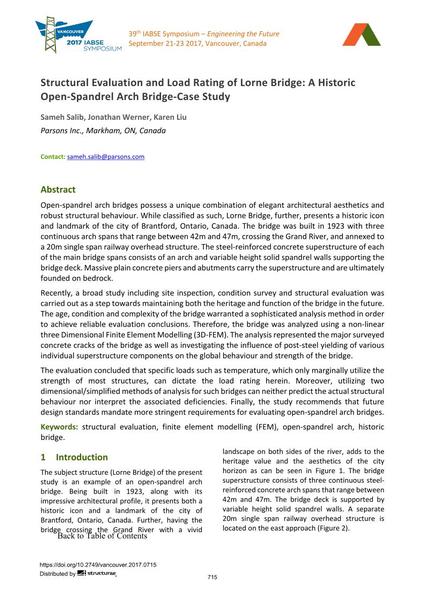Structural Evaluation and Load Rating of Lorne Bridge: A Historic Open-Spandrel Arch Bridge-Case Study

|
|
|||||||||||
Bibliographic Details
| Author(s): |
Sameh Salib
(Parsons Inc., Markham, ON, Canada)
Jonathan Werner (Parsons Inc., Markham, ON, Canada) Karen Liu (Parsons Inc., Markham, ON, Canada) |
||||
|---|---|---|---|---|---|
| Medium: | conference paper | ||||
| Language(s): | English | ||||
| Conference: | IABSE Symposium: Engineering the Future, Vancouver, Canada, 21-23 September 2017 | ||||
| Published in: | IABSE Symposium Vancouver 2017 | ||||
|
|||||
| Page(s): | 715-721 | ||||
| Total no. of pages: | 7 | ||||
| Year: | 2017 | ||||
| DOI: | 10.2749/vancouver.2017.0715 | ||||
| Abstract: |
Open-spandrel arch bridges possess a unique combination of elegant architectural aesthetics and robust structural behaviour. While classified as such, Lorne Bridge, further, presents a historic icon and landmark of the city of Brantford, Ontario, Canada. The bridge was built in 1923 with three continuous arch spans that range between 42m and 47m, crossing the Grand River, and annexed to a 20m single span railway overhead structure. The steel-reinforced concrete superstructure of each of the main bridge spans consists of an arch and variable height solid spandrel walls supporting the bridge deck. Massive plain concrete piers and abutments carry the superstructure and are ultimately founded on bedrock. Recently, a broad study including site inspection, condition survey and structural evaluation was carried out as a step towards maintaining both the heritage and function of the bridge in the future. The age, condition and complexity of the bridge warranted a sophisticated analysis method in order to achieve reliable evaluation conclusions. Therefore, the bridge was analyzed using a non-linear three Dimensional Finite Element Modelling (3D-FEM). The analysis represented the major surveyed concrete cracks of the bridge as well as investigating the influence of post-steel yielding of various individual superstructure components on the global behaviour and strength of the bridge. The evaluation concluded that specific loads such as temperature, which only marginally utilize the strength of most structures, can dictate the load rating herein. Moreover, utilizing two dimensional/simplified methods of analysis for such bridges can neither predict the actual structural behaviour nor interpret the associated deficiencies. Finally, the study recommends that future design standards mandate more stringent requirements for evaluating open-spandrel arch bridges. |
||||
| Keywords: |
finite element modeling (FEM) historic bridge structural evaluation open-spandrel arch
|
||||
